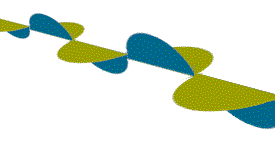Electromagnetic Waves (original) (raw)
magnetic field ---> electric current ---> magnetic field ---> electric current ---> ...
There was one stumbling block. Such a wave could not exist in empty space, because empty space contained no copper wires and could not carry the currents needed to complete the above cycle. A brilliant young Scotsman, James Clerk Maxwell, solved the riddle in 1861 by proposing that the equations of electricity needed one more term, representing an electric current which could travel through empty space, but only for very fast oscillations.
With that term added (the "displacement current"), the equations of electricity and magnetism allowed a wave to exist, propagating at the speed of light. The drawing below illustrates such a wave--green is the magnetic part, blue the electric part--the term Maxwell added. The wave is drawn propagating just along one line. Actually it fills space, but it would be hard to draw that.
 |
|---|
| Electromagnetic Wave (see text above) |
Maxwell proposed that it indeed was light. There had been earlier hints--as noted above, the velocity of light had appeared unexpectedly in the equations of electricity and magnetism--and further studies confirmed it. For instance, if a beam of light hits the side of a glass prism, only part of it enters--another part gets reflected. Maxwell's theory correctly predicted properties of the reflected beam.
Then Heinrich Hertz in Germany showed that an electric current bouncing back and forth in a wire (nowadays it would be called an "antenna") could be the source of such waves. (The current also produces a magnetic field in accordance with Ampere's law, but that field decreases rapidly with distance.) Electric sparks create such back-and-forth currents when they jump across a gap--hence the crackling caused by lightning on AM radio--and Hertz in 1886 used such sparks to send a radio signal across his lab. Later the Italian Marconi, with more sensitive detectors, extended the range of radio reception, and in 1903 detected signals from Europe as far as Cape Cod, Massachussets.
It was presumed that light from the hot wire of a lightbulb was emitted because the heat caused electrons to bounce back and forth rapidly, turning each into a tiny antenna. When physicists tried to follow that idea, however, they found that the familiar laws of nature had to be modified on the scale of atomic sizes. That was how quantum theory originated.
Gradually other electromagnetic waves were found The wave nature of light causes different colors to be reflected differently by a surface ruled in fine parallel scratches--which is why a compact laser disk (for music or computer use) shimmers in all colors of the rainbow. The orderly rows of atoms in a crystal also form parallel lines but spaced much more closely, and they turned out to have the same effect on X-rays, showing that X-rays, like light, also were electromagnetic waves, but of a much shorter wavelength. Later it was found that beams of electrons in a magnetic field, inside a vacuum tube, could become unstable and emit waves longer than light: the magnetron tube where this occured was a top-secret radar device in World War II, and it later made the microwave oven possible.
Electromagnetic waves led to radio and television, and to a huge electronic industry. But they are also generated in space--by unstable electron beams in the magnetosphere, as well as at the Sun and in the far-away universe, telling us about energetic particles in distant space, or else teasing us with unresolved mysteries. You can find more about this in the section on high energy particles.
Questions from Users:
*** Are electric storms an "electromagnetic" phenomenon?
*** What is "Radiation"?
*** What exactly does "Radiation" Mean?
*** There are electromagnetic waves all around us!
*** How come a magnetic field can block particle radiation but not light?
*** Electromagnetic Waves and Electromagnetic Induction
*** Why doesn't magnetism affect electro-magnetic waves?